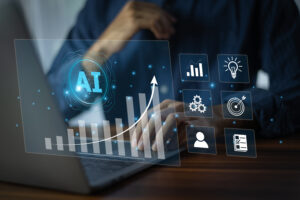*I frequently get asked questions about Data Science, so in the interest of helping as many people as possible, I’ve started this blog to answer those questions as simply as possible. This is a robust topic, and if you want a more in-depth discussion, please revisit my blog, where we will be going into greater depth at another time.
Artificial intelligence and machine learning often go hand-in-hand. However, they each have characteristics and differences that set them apart. Both are prominent in industries from marketing to healthcare and make appearances in daily life. But as tech continues to evolve, knowing the difference is crucial.
Artificial intelligence and machine learning are two different types of technology. They primarily aim to automate tasks and make life easier. In this vastly digital world that is constantly expanding, it’s essential to know the difference between these two types of tech.
What are artificial intelligence and machine learning? How do they differ, and why does it matter? What can they do, and what are they used for? Here’s what you need to know.
Table of Contents
What is Artificial Intelligence?
How Does Artificial Intelligence Work?
How Can Artificial Intelligence Be Used?
#1. Artificial Intelligence in Investing
#2. Artificial Intelligence in Health Care
#3. Artificial Intelligence in Manufacturing
#4. Artificial Intelligence in Customer Service
#5. Artificial Intelligence in Marketing
What Can Machine Learning Be Used For?
#1. Machine Learning in Data Mining and Data Science
#2. Machine Learning in Banking
#3. Machine Learning in Self-Driving Cars
#4. Machine Learning in Speech Recognition
#5. Machine Learning in Image Recognition
What is Artificial Intelligence?
Artificial intelligence and machine learning are often interchangeable, but that’s not entirely accurate. To break things down:
“Artificial intelligence is generally the ability of a computer to mimic human thought. AI can perform tasks in real-time and real-world environments.”
Ultimately, the main goal of developing computers, robots, and programs with artificial intelligence is to create autonomous machines. These machines think and act like humans and are capable of learning and problem-solving. From Siri on Apple devices to the Amazon Alexa to customer service chatbots, many people encounter artificial intelligence at several points in their day.
Artificial intelligence is often used as an umbrella term encompassing all the efforts to teach computers human behavior or complex tasks. To be more specific, there are four different types of artificial intelligence:
- Reactive Machines
- Limited Memory
- Theory of Mind
- Self-Awareness
#1. Reactive Machines
Reactive machines are the most basic types of artificial intelligence. They’re solely reactive, meaning they can’t form memories or use past experiences to inform decisions. Take IBM’s chess-playing computer, Deep Blue, for example. It is a reactive machine that can identify various game pieces to make decisions. However, it has no concept of the previous moves.
Because these reactive machines do not recall past events, this artificial intelligence is best used for specialized tasks. Online gaming is a perfect application.
#2. Limited Memory
Limited memory artificial intelligence machines can look into past events and gather data. This is something that self-driving cars do a little bit of already. They operate by observing other cars’ speeds and directions, then track and monitor patterns over time.
This info is added to the car’s preprogrammed view of the world, including traffic lights, how different lane markings look, and what they mean. However, because this type of artificial intelligence has limited memory, this information isn’t permanent. Data is not stored in the car’s library and doesn’t necessarily build upon its driving experience.
#3. Theory of Mind
The theory of mind artificial intelligence has roots in psychology. In psychology, the theory of mind is the understanding that people, creatures, and objects have thoughts and emotions affecting their behavior. This concept is critical to society because it plays a substantial role in human interaction. The ability to understand others’ ideas and feelings is crucial. It’s also vital for artificial intelligence machines to maintain their places in society.
#4. Self-Awareness
Self-awareness in artificial intelligence is due to the machine’s ability to have a sense of consciousness. Conscious beings, like humans, are aware of themselves and their surroundings. They know what they want and how they feel. This helps them make inferences about other people’s feelings. Fully self-aware artificial intelligence may be far off in the future. However, there are several different facets of artificial intelligence to master first.
How Does Artificial Intelligence Work?
Understand how AI works. It combines large data sets with intelligent algorithms that can learn from patterns analyzed in data. Artificial intelligence is so convenient because it doesn’t need to take breaks. Unlike humans, it can run thousands of tasks at a rapid pace without needing to pause.
It’s also important to note that AI isn’t just one program or computer. Instead, it’s more of a science that uses many techniques, processes, and technologies to achieve goals.
What is Machine Learning?
On the other hand, machine learning is more like a pathway to artificial intelligence. It’s a branch of artificial intelligence and computer science that uses specific algorithms and analytics. Machines learn insights, recognize patterns from data, and then apply that information to solve problems and make decisions.
Machine learning is a way for programmers to test the limits of machines and see how much a computer system’s cognition can be improved. The device imitates how humans learn by gradually improving over time. This sets machine learning apart from some of the most basic forms of artificial intelligence. It can evolve and build upon itself by extracting useful information from data it encounters.
How machine learning works varies greatly depending on the type of machine learning. Each requires a different level of computing power, programming, and set algorithms to work and carry out tasks effectively. The three types of machine learning include:
- Supervised Learning
- Unsupervised Learning
- Reinforcement Learning
#1. Supervised Learning
With supervised learning, input and output data are fed to the machine learning algorithm. The algorithm then processes each data pair to create outcomes closely aligned with the desired results.
In this type of machine learning, you have to feed the algorithm data to help it learn. It doesn’t just pull data and information automatically. Supervised learning is ideal for sales forecasting, inventory management, and determining loan applicant risk levels.
#2. Unsupervised Learning
Unsupervised learning doesn’t require human interference to help the machine learn. Instead, the device looks for patterns in the data to help make decisions. These machines learn from choice to create predictive models.
This type of machine learning is helpful for clustering and grouping. You can use unsupervised machine learning to organize customers based on purchasing behaviors and then group inventory based on different manufacturing metrics.
#3. Reinforcement Learning
Reinforcement learning is the best in terms of closely mimicking how humans learn. This type of machine learning learns by interacting with its environment and receiving either positive or negative rewards, or reinforcements, for doing so.
This type of machine learning requires much computing power and far less management. Therefore, it’s easier to use. Reinforcement machine learning is best used to teach cars to self-park and self-drive and control traffic lights more dynamically to reduce traffic jams.
How Can Artificial Intelligence Be Used?
“As technologies continue to evolve and improve, the possibilities for artificial intelligence are practically endless. Already, AI goes to great lengths to serve various fields.”
Some of the areas in which artificial intelligence is already seeing a tremendous uptick include:
- Investing
- Healthcare
- Manufacturing
- Customer service
- Marketing
#1. Artificial Intelligence in Investing
Artificial intelligence can prove very useful for managing investment portfolios and assets. Artificial intelligence-based technology like robo-advisors help improve access and democratize the stock market and investing process.
This intelligent robotic investment management technology can identify patterns, provide detailed reports, and offer insights. They help make investments for you based on specific criteria. Artificial intelligence allows what used to be a rather tedious and costly process to become more accessible and streamlined, thus inviting more people into the investing field.
#2. Artificial Intelligence in Health Care
Data is vast in the healthcare field. Caregivers rely significantly on patterns and analytics provided by data to give accurate and efficient services. Artificial intelligence technologies can help improve this and ensure the data is accurately analyzed.
Artificial intelligence can analyze data from patient health records. It can also capture and record patient interactions to predict outcomes of hospital visits. This type of AI helps prevent readmissions and reduces hospital stay times.
#3. Artificial Intelligence in Manufacturing
The manufacturing industry relies heavily on efficiency, and artificial intelligence can help ensure that. AI can automate various processes by applying data analytics and even machine learning. It can also identify equipment errors before major malfunctions occur. This helps people monitor machine production and keep track of maintenance and energy consumption.
#4. Artificial Intelligence in Customer Service
When most people encounter artificial intelligence in their day-to-day lives, it’s likely via chatbots through the “live chat” feature companies offer online customers. Artificial intelligence chatbots also use machine learning and eventually build up a database of answers to respond to questions.
Using chatbots takes some stress off companies to staff customer service teams and allows companies to provide 24/7 support. These chatbot interactions will only improve as artificial intelligence technology continues improving.
#5. Artificial Intelligence in Marketing
Artificial intelligence technology is also instrumental in marketing. It’s beneficial for delivering targeted and personalized ads using behavioral analysis and pattern recognition. AI can also handle other routine tasks like providing campaign and engagement reports.
What Can Machine Learning Be Used For?
Like artificial intelligence, machine learning has several uses across various fields and industries.
“Artificial intelligence and machine learning sometimes combine to create valuable technologies that improve workflow.”
Some of the areas where machine learning is helpful might include:
- Data Mining and Data Science
- Banking
- Self-Driving Cars
- Speech Recognition
- Image Recognition
#1. Machine Learning in Data Mining and Data Science
Data mining is finding irregularities, patterns, and correlations within data sets to predict outcomes. Data science is the field of study that deals with large sets of data. It helps find relationships, gathers meaningful information, and makes business decisions based on those findings.
Data science uses complex machine learning algorithms to build predictive models based on the data. Machine learning is crucial to both these fields because it provides the tools necessary for gathering the data, determining relationships, and making predictions.
#2. Machine Learning in Banking
“Both machine learning and artificial intelligence are helpful in the banking industry, specifically for data privacy and security.”
Machine learning can detect and prevent fraud and cybersecurity attacks, authenticate user identities, and even automate customer service processes. It can also be used in the stock market to predict market trends for traders looking to evaluate risk before making trades.
#3. Machine Learning in Self-Driving Cars
Machine learning is a big part of what makes self-driving cars possible. Companies like Tesla use machine learning to allow these self-driving vehicles to collect data on their surroundings. The computers then evaluate it and take action based on what may happen. This is done through the use of cameras and sensors around the car. Ultimately, these machine learning algorithms aim to perform tasks as well as or even better than humans.
#4. Machine Learning in Speech Recognition
Speech recognition covers functions like “search by voice” and “speech to text.” Essentially, speech recognition is the process of converting voice instructions into text, thanks to machine learning. Machine learning applications in the speech recognition process the sounds and filter out unnecessary static. Products like Alexa, Siri, Google Assistant, and Cortana use machine learning for speech recognition.
#5. Machine Learning in Image Recognition
Similar to speech recognition, machine learning is also prominent in image recognition. Image recognition uses machine learning algorithms to identify objects, places, and people. Image recognition has a wide variety of uses. It helps with x-ray labeling, social media tagging, and even facial recognition for security on personal devices like smartphones.
Conclusion
Artificial intelligence and machine learning are two different types of technology. They both have the primary goal of automating tasks and making life more accessible through technology. Both artificial intelligence and machine learning also have a wide variety of uses across several fields and industries.
This technology is also present in everyday life, from facial recognition to customer service chatbots. In this vast digital world constantly expanding, it’s essential to know the differences between these two types of tech and what they can do.
 About the Author
About the Author
Tiffany Perkins-Munn orchestrates aggressive strategies to identify objectives, expose patterns, and implement game-changing solutions with the agility that transcends traditional marketing. As the Head of Data and Analytics for the innovative CDAO organization at J.P. Morgan Chase, her knack involves unraveling complex business problems through operational enhancements, augmented financials, and intuitive recruiting. After over two decades in the industry, she consistently forges robust relationships across the corporate spectrum, becoming one of the Top 10 Finalists in the Merrill Lynch Global Markets Innovation Program.
Dr. Perkins-Munn earned her Ph.D. in Social-Personality Psychology with an interdisciplinary focus on
Advanced Quantitative Methods. Her insights are the subject of countless lectures on psychology,
statistics, and real-world applications. As a published author, coursework developer, and
Dissertation Committee Chair Tiffany still finds time for family and hobbies. Her non-linear career path
has given her an exclusive skill set that is virtually impossible to reproduce in another individual.









One Response
Thanks for sharing. I read many of your blog posts, cool, your blog is very good.